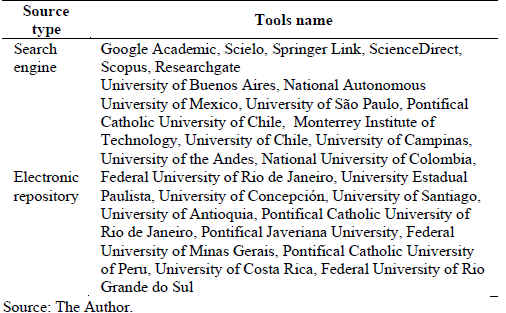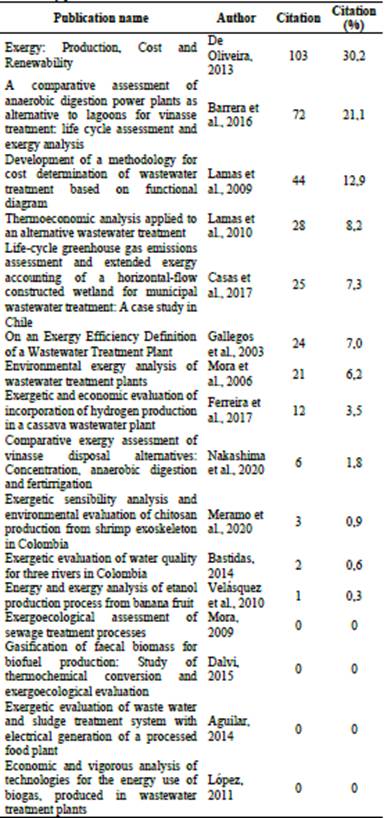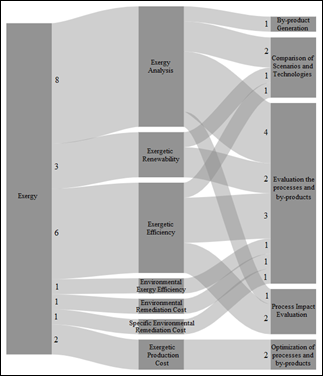1. Introduction
Water resource management is made up of the collection, treatment, distribution and use of water, second collection, treatment and discharge of wastewater into the environment [1]. Wastewater treatment is critic for pollutants reduction and water quality improvement, due to socioeconomic, agricultural and industry development, population growth and low social and political attention generate an increment on pollution load and volume of wastewater [2-5].
Wastewater is composed of water (99,9%) and solids (0,01%) that generate physical, chemical and microbiology pollution, causing damage to the environment and public health [6-8]. Wastewater is considered a mixture of one or many effluents such as industrial, hospital, domestic (black and gray water), commercial, institutional, horticultural, aquacultural wastewater, agricultural runoff, rainwater and other urban runoff [9]. The industrial effluent is responsible for producing 60% of biochemical oxygen demand (BOD), 60% of suspended solids, 90% of toxic waste in water and 75% of organic waste [10].
Worldwide, more than 80% of wastewater is discharged into the environment without adequate treatment [8]. In LatAm, 70% to 80% urban sewerage system water is discharged into the environment without adequate treatment, the treatment of the remaining wastewater is carried out through technologies such as stabilization ponds, activated sludge and upflow anaerobic sludge blanket reactors [11-13].
Driven by environmental regulations, the focus of wastewater treatment has traditionally been the quality of the effluent and not necessarily energy or resource efficiency [14]. Nevertheless, the process energy efficiency and potential recovery of by-products such as energy, nutrients, organic matter, metals, among others promote wastewater system sustainability [8].
Calculating exergy allows to determine wastewater system sustainability, which means, knowing the maximum useful work that can be obtained from the system in a specific state and environment, this work could be converted into energy used for wastewater systems and other processes [15-18].
Exergy concept is based on the first law of thermodynamics that corresponds to the conservation principle of energy which states that nothing disappears because energy cannot be created or destroyed [19,20] and the second law of thermodynamics is related to the quality of energy, which specifically deals with the degradation of energy during a process [21].
The modern development of exergy analysis was presented by Bosnjakovic in Europe and Keenan in United States [22]. Then in 1950s and 1960s Rant, Grassmann, Brodyansky, Bruges, Keenan, Tribes, Obert, Gaggioli, Evans, Baehr, and Fratzscher made fundamental contributions to the concept of exergy and the publication of research on energy engineering journals continues [23-25].
The historical focus of multiple investigations on exergy is shown in articles by Rezac and Metgalchi in 2004 and Sciubba and Wall 2007; nevertheless, those articles do not include wastewater systems [9,22]. It resulted in the research question: What are the studies and uses of exergy for wastewater systems in LatAm? The development of this review article seeks to make a bibliometric analysis on the study and use of exergy in wastewater systems in LatAm from 2000 to June 2020.
2. Materials and methods
2.1 Documental review
Documentary review was made from exergetic research, carried out in wastewater systems in LatAm. Secondary information search was done with search engines and electronic repositories of the twenty best universities of the region, shown in Table 1 [26].To identify the greatest number of publications, the following keywords were used: exergy, energy availability, exergy analysis, exergetic analysis, exergetic diagnosis, wastewater, treatment plant, Latin America, Argentina, Bolivia, Brazil, Chile, Colombia, Costa Rica, Cuba, Ecuador, El Salvador, Guatemala, Haiti, Honduras, Mexico, Nicaragua, Panama, Paraguay, Peru, the Dominican Republic, Uruguay and Venezuela; their combinations in Spanish, Portuguese and English equivalents.
The inclusion criteria for the documentary review is the research on the study and use of exergy in wastewater systems in LatAm.
Systematization and filling of the documents found were effectuated through the bibliographic manager Mendeley® Desktop version 1.19.4, where duplication was eliminated and chronological production, authors and citations from publications were identified. Also, the organization of the publications was complemented by using Microsoft Excel® software spreadsheet.
2.2 Bibliometric analysis
For the bibliometric analysis the type of publication, geographic location, thematic category and purpose of the study were taken into account.
2.2.1 Type of publication:
This document includes the research and it is categorized in: 1) Article: short and specific document, with unique electronic identification using the digital object indicator - DOI or International Standard Publication Number Serials - ISSN. 2) Book: a unitary long publication in one or several volumes and registered with the International Standard Book Number - ISBN. 3) Thesis: written research work to apply for a professional undergraduate or graduate degree.
2.2.2 Geographic location
Territorial location of the country in which the document was published and the case study of the publication.
2.2.3 Thematic categories
Topics where the exergy concept is used: 1) Exergy analysis: detailed examination of maximum useful work that can be obtained from total system exergy (physical, chemical, kinetic, and potential) [27]. 2) Exergetic efficiency: quantitative evaluation of the perfection degree or irreversibility of a process, equipment or installation [28]. 3) Environmental exergy efficiency: relationship between the final product exergy and the total exergy consumed by human and natural resources, including all the exergy inputs [29]. 4) Exergetic renewability: exergy associated to useful products of a given energy conversion process, destroyed exergy, exergy associated to the fossil fuels required, exergy needed to deactivate the waste, and by-products and non-treated waste exergy [30]. 5). Environmental remediation cost: exergy resources consumed in effluent treatment, to bring it to a state of balance with the environment before being discharged into the environment [31]. 6) Specific environmental remediation cost: exergy resources consumed for the removal of BOD5 [15]. 7) Exergetic production cost: total minimum (optimal) operating costs of the process [32].
3. Results
3.1 Documental review
Search engines and electronic repositories retrieved 5,459 records as a result of multiple combinations of keywords. A total of 62 publications met the inclusion criteria, from which 46 were excluded due to duplication, resulting in 16 publications relevant to bibliometric analysis.
The chronology of publications is represented by an annual average of 0.8 publications, with a maximum of 2 publications per year and for the second decade in study of 21st century, the number of publications per year increased by 167% compared to the first decade (Fig. 1).
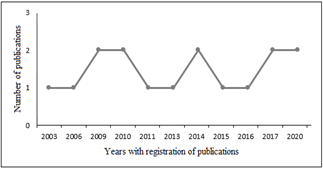
Source: The Author.
Figure 1 Publications per year between 2000-2020 on study and use of exergy in wastewater systems in Latin America.
The documentary review identified 34 authors who published about exergy study and use for wastewater systems in LatAm, of which 14 are main authors and De Oliviera has the largest participation in publications (18,75%) and publications (6,25%), being the pioneer and with the largest associated participation in publications.
The total number of citations found is 314, the book by De Oliviera (30.2%) and the article by Barrera and collaborators (21.1%) are the most cited publications and the remaining represent 48.7% with values between 0 and 12.9% shown in Table 2.
3.2 Bibliometric analysis
Author prefer to publish articles (63%) followed by undergraduate and postgraduate theses (31%) and finally books (6%).
Brazil, Colombia and Mexico are the countries with the largest number of documents published and according to the case study of the publications (Fig. 2), only Mora’s thesis has two studies in Brazil and one in Colombia.
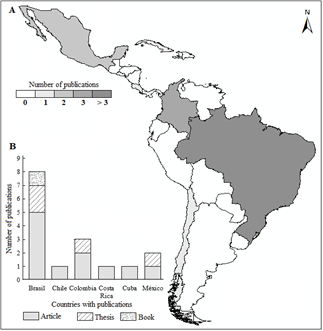
Source: The Author.
Figure 2 Geographical origin of publications of exergy study and use for wastewater systems in Latin America, 2000-2020. A) Publications by country. B) Number and type of publications by country.
The exergy analysis (36%), exergetic efficiency (27%) and exergetic renewability (14%) have been the main topics of study in LatAm and 23% represents environmental exergy efficiency and the cost of environmental remediation, specific environmental remediation and exergetic production (Fig. 3). The objective of these topics was evaluating the processes and by-products as well as comparing scenarios and technologies.
4. Discussion
Besides, the low number of researchers and institutions evidenced a low publishing number compared to exergy studies by Rezac and Metgalchi in 2004 and Sciubba and Pared in 2007. The chronological production began in 2003 and the first worldwide exergy studies were published in 1870 and from the 1970s his research has been in progress [9,33]. Tai et al. (1986) first research publication on exergy estimation in a wastewater system.
From 2000 to 2020, the documents published had an annual average of 0.8 publications, highlighting the second decade of study with an increase of 167% of publications per year for LatAm. However, Sciubba and Wal, 2007 defined the application of exergy as exponential growth until 2004, while Seabra and Caldeira, 2020 determined an annual average of 78.38 publications until 2000 and an annual average of 918.28 before 2019. Thus, LatAm research is 17 years behind the world (Table 2).
In LatAm, exergy research is funded by government institutions that have limited resources, without support and participation from the private industry [34]. This study evidenced that 81% of the publications were made in public university research centers, mainly in Brazil, Colombia and Mexico. Unlike the world context, the oil crisis in 1973 forced the government institutions and private companies to invest in solutions for saving energy and increasing the energy efficiency of processes [22]. It is clear that this model has not been visible in LatAm even when efficient use of energy is compulsory.
To comply with international energy treaties and conventions, global energy efficiency policies and the Sustainable Development Goals - SDGs [35], LatAm requires forming alliances and strategies to address exergy studies in wastewater systems because exergy or useful work could be converted into energy used for wastewater systems and other processes. Based on the above information, to study and implement exergy applications in wastewater systems, it is necessary to promote training and formation for professional researchers in this field, public-private articulation to develop Exergy studies applied to local industries, the creation of schools of thought and long-term work groups along with innovation in technologies to minimize negative impacts from the concept of exergy.
In general, exergy research is oriented to exergy analysis for energy fuels, making wastewater systems remain overlooked and with fewer resources [36-38]. Nonetheless, exergy analysis is the most examined research topic in LatAm and worldwide, that even the standard way in which exergy analysis is used has been established [39].
Achieving the sustainable development objective called clean water and sanitation is possible if exergy studies are approached. Provision of clean water and sanitation services are priorities for developing countries. These countries disregard the negative impacts of wastewater management and pollution because they are not aware of their importance and how they affect human health and the environment [40]. Nevertheless, the applicability of exergy in wastewater systems would allow nutrient recovery and by-products performance improvement. it could also be used to reduce polluting loads and maximize the exergetic efficiency of wastewater treatment systems. Lastly, exegetical indices and indicators could be formulated as a control strategy that allows a comparative evaluation of the system performance and optimization.
5. Conclusions
The results showed an incipient exergy research development in wastewater systems for LatAm in last two decades.
LatAm research is 17 years behind the world and it is not ongoing due to the few research schools and the low interest in the study of exergy in wastewater systems.
To study and implement exergy applications in wastewater systems, it requires promoting training and formation for professional researchers in this field, and public-private articulation to develop exergy studies applied to local industries.
Achieving the sustainable development objective called clean water and sanitation is possible if exergy studies are approached, and the positive impact of exergy applicability on wastewater systems would help achieve the following sustainable development goals: affordable and clean energy, climate action, underwater life, and terrestrial ecosystem life.













